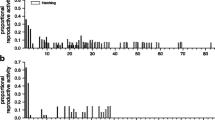Abstract
In the hermaphrodite freshwater snail Bulinus truncatus, two sexual morphs, euphallic (regular hermaphrodites) and aphallic individuals without a male copulatory organ, co-occur at various ratios in natural populations. Both aphallic and euphallic individuals can reproduce by selfing, but when outcrossing aphallic individuals can only play the female role. A comparison of life-history traits and sex allocation in these two forms provides the opportunity to investigate the evolution and maintenance of sexual polymorphisms. This study was performed to test whether a reallocation of resources from the lost male function to the female function occurs in aphallic snails at the level of both sex organs (sex allocation) and life-history traits. In a first experiment we compared life-history traits over a whole life-cycle under selfing between the two sexual morphs. In a second experiment, the sex organs were weighed to test for a difference in sex allocation between the two morphs. No difference in resource allocation to female function between the two morphs was observed in either experiment. This is in contrast to patterns frequently observed in sexually polymorphic plants, and in a previous study performed on aphally in the same snail species. We discuss the genetic and physiological hypotheses that could explain these results, and their consequences for the evolution and maintenance of phally polymorphism in B. truncatus.
Similar content being viewed by others
References
Baker RJ, Nelder JA (1985) The GLIM system, release 3.77, manual. Numerical Algorithms Group, Oxford
Baur B, Chen X (1993) Genital dimorphism in the land snail Chondrina avenacea: frequency of aphally in natural populations and morph-specific allocation to reproductive organs. Veliger 36:252–258
Brown DS (1994) Freshwater snail of Africa and their medical importance. Taylor and Francis, London
Charlesworth D, Charlesworth B (1978) Population genetics of partial male-sterility and the evolution of monoecy and dioecy. Heredity 47:137–153
Charnov EL (1982) The theory of sex allocation. Princeton University Press, Princeton
Crawley MJ (1993) GLIM for ecologists. Blackwell, Oxford
Cook LM, Lace LA (1993) Sex and genetic variation in a helicid snail. Heredity 70:376–384
David P, Delay B, Berthou P, Jarne P (1995) Alternative models for allozyme-associated heterosis in the marine bivalve Spisula ovalis. Genetics 139:1719–1726
Delph LF (1990) Sex-ratio variation in the gynodioecious shrub Hebe strictissima (Scrophulariaceae). Evolution 44:134–142
Doums C, Bremond P, Delay B, Jarne P (1996) The genetical and environmental determination of phally polymorphism in the freshwater snail Bulinus truncatus. Genetics, 142:217–225
Duncan CJ (1975) Functional anatomy and physiology. In: Fretter V, Peake J (eds) Pulmonates: reproduction. Academic Press, London, pp 309–365
Fryer S, Oswald RC, Probert AJ, Runham NW (1990) The effect of Schistosoma haematobium infection on the growth and fecundity of three sympatric species of bulinid snails. J Parasitol 76:557–563
Gouyon PH, Couvet D (1987) A conflict between two sexes, females and hermaphrodites. In: Stearns SC (ed) The evolution of sex and its consequences. Birkhäuser, Basel, pp 245–261
Hamza F (1992) Bulinus truncatus (Audoin, 1827) d'Algérie. Recensement de ses biotopes dans le Nord-Est algérois. Structure de ses populations méditerranéennes. Comparaison avec deux populations sahariennes. Ph D thesis, Université des Sciences et de la Technologie, Houari Boumedienne, Algeria
Hirshfield MF, Tinkle DW (1975) Natural selection and the evolution of reproductive effort. Proc Natl Acad Sci USA 72:2227–2231
Jarne P, Finot L, Bellec C, Delay B (1992) Aphally versus euphally in self-fertile hermaphrodite snails from the species Bulinus truncatus (Pulmonata: Planorbidae). Am Nat 139:424–432
Larambergue M de (1939) Etude de l'autofécondation chez les Gastéropodes Pulmonés. Recherches sur l'aphallie et la fécondation chez Bulinus (Isidora) contortus Michaud. Bull Biol France Belg 73:19–213
Loyd DG (1979) Some reproductive factors affecting the selection of self-fertilization in plants. Am Nat 113:67–79
McCullagh HP, Nelder JA (1983) Monographs on statistics and applied probability. Chapman and Hall, University Press, Cambridge
Molina-Freaner F, Jain SK (1992) Female frequencies and fitness components between sex phenotypes among gynodioecious populations of the colonizing species Trifolium hirtum All. in California. Oecologia 92:279–286
Njiokou F, Bellec C, Berrebi P, Delay B, Jarne P (1993) Do self-fertilization and genetic drift promote a very low genetic variability in the allotetraploid Bulinus truncatus (Gastropoda: Planorbidae) populations? Genet Res 62:89–100
Pokryszko BM (1987) On the aphally in the vertiginidae (Gastropoda: Pulmonata: Orthurethra). J Conchol 32:365–375
Reznick D (1985) Costs of reproduction: an evaluation of the empirical evidence. Oikos 44:257–267
SAS Institute (1990) SAS user's guide: statistics, version 6 SAS Institute, Cary
Schoen DJ, Lloyd DG (1984) The selection of cleistogamy and heteromorphic diaspores. Biol J Linn Soc 23:303–322
Schrag SJ, Read A (1992) Temperature determination of male outcrossing ability in a simultaneous hermaphrodite. Evolution 46:1698–1707
Schrag SJ, Rollinson D (1994) Effects of Schistosoma haematobium infection on reproductive success and male outcrossing ability in the simultaneous hermaphrodite, Bulinus truncatus (Gastropoda: Planorbidae). Parasitology 108:27–34
Schrag SJ, Ndifon T, Read AF (1994) Temperature-determined outcrossing ability in wild populations of a simultaneous hermaphrodite snail. Ecology 75:2066–2077
Seed R (1980) Shell growth and form in the Bivalvia. In: Rhoads PC, Lutz RA (eds) Biological records of environmental change. New York, pp 23–67
Sokal RR, Rohlf FJ (1995) Biometry. 3rd edn. Freeman, San Francisco
Stearns SC (1989) Tradeoffs in life history evolution. Funct Ecol 3:259–268
Thomas JD, Grealy B, Fennell CF (1983) The effects of varying the quantity and quality of various plants on feeding and growth of Biomphalaria glabrata (Gastropoda). Oikos 41: 77–90
Winner BJ, Brown DR, Kenneth M (1991) Statistical principles in experimental design. 2nd edn. McGraw-Hill, New York
Author information
Authors and Affiliations
Corresponding author
Rights and permissions
About this article
Cite this article
Doums, C., Jarne, P. The evolution of phally polymorphism in Bulinus truncatus (Gastropoda, Planorbidae): the cost of male function analysed through life-history traits and sex allocation. Oecologia 106, 464–469 (1996). https://doi.org/10.1007/BF00329703
Received:
Accepted:
Issue Date:
DOI: https://doi.org/10.1007/BF00329703




